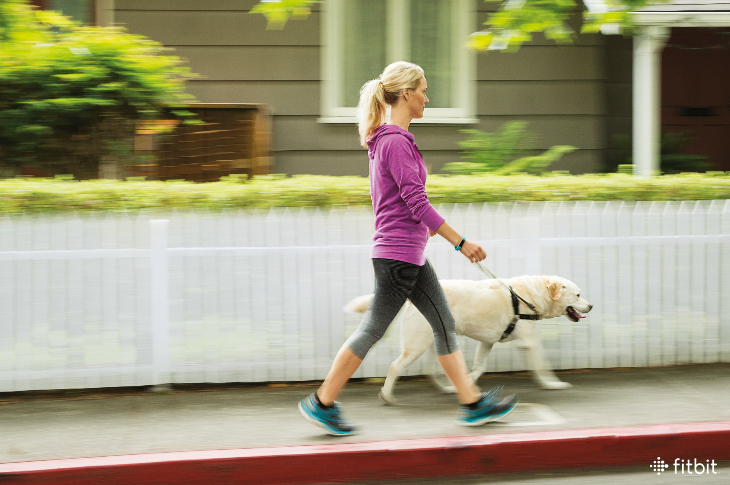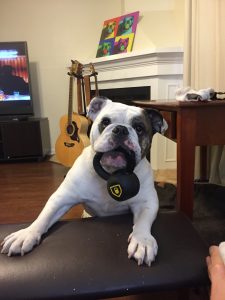 Every day for nine years, Jess Martin walked his English bulldog, Marilyn, to a park near his Austin, Texas home. Once there, Martin would let Marilyn run around and play, and then they’d walk back, feeling happier and a little bit healthier.
Every day for nine years, Jess Martin walked his English bulldog, Marilyn, to a park near his Austin, Texas home. Once there, Martin would let Marilyn run around and play, and then they’d walk back, feeling happier and a little bit healthier.
As a Fitbit Local ambassador and the owner of Stronghorn Fitness, Martin knows well the benefits of dog walking, both for furry friends and their owners. Dog owners who regularly walk their pets exercise an average of 22 minutes more per week than non-dog owners. And yet, 40 percent of dog owners aren’t walking their canine companions, in part because they believe the dog is too old, too sick, or too fat.
The problem is that many people don’t consider walking the dog to be a good workout. But, says Martin, nothing could be further from the truth. “The health benefits of just going on a walk are countless,” says Martin. “And if you go on that walk with intention, it not only turns your walk into a workout, it also becomes a bonding experience with your fur baby.”
The key, says Martin, is to avoid walking around aimlessly. “Put rules in place so that every block you walk or every corner you turn, you do something,” says Martin. His total-body, dog-walking routine below will help you get started.
How to Squeeze in a Total-Body Workout While Walking Your Dog
Warm-up:
“Dogs and humans need to get the blood flowing before they move into more vigorous exercise,” says Martin. So for the first block or two just concentrate on gradually ramping up to a brisk pace. “Most pups can move quite fast, regardless of size,” says Martin. “But if your fur baby is struggling to keep up, make the warm-up walk slower, but longer. Using your Fitbit device, aim to get your heart rate into the fat-burning zone (50 to 69 percent of your max). If you’re not using a device with heart-rate tracking, let the “talk test” be your guide—you should be able to hold a conversation while walking, but not sing.
At each corner (or every two blocks):
Do 10 squats or 10 standing push-ups against a stable structure, such as a fence, keeping your movements slow and controlled and maintaining a firm grip on the leash.
Squats: Stand with your feet shoulder-width apart and your arms straight out in front of you. Keeping your knees in line with your toes and your hips back, lower yourself as if you were going to sit in a chair. When your thighs are parallel with the ground, pause, then slowly stand up.
Fence push-ups: Facing a fence, stand about an arm’s length away with your palms flat against the fence, shoulder-width apart. Keeping your feet flat on the ground, bend your elbows and slowly lean into the fence. When your elbows are at a 90-degree angle, pause, then push back until your arms are straight.
Every time your pup stops to smell the bushes:
Instead of rushing him or her, use this time to do some squat holds, suggests Martin.
Squat hold: Stand with your feet shoulder-width apart. Keeping your knees in line with your toes and your hips back, lower yourself until your thighs are parallel with the ground. Hold there for 45 seconds to one minute minute. Be sure to keep your chest up, your shoulders back, and your core engaged.
During potty breaks:
When your dog stops to do its business, you can do some interval training in the form of alternating toe taps on the curb.
Toe taps: Stand facing the curb with your right toe on the curb and your left foot on the ground. Using a hopping motion, switch positions, so that your left toe is on the curb and your right foot is on the ground. Continue quickly alternating your feet for 30 seconds to a minute.
At the dog park:
On days you head to the dog park (either on foot or in the car), add in some aerobic fun. Throw a ball as far as you can. While your pup races to retrieve it, do some jump lunges—or regular lunges if plyometric exercises aren’t in the cards. “The beauty of this exercise is that your dog is the timer,” says Martin. “The farther you throw the ball, the longer it will take him or her to bring it back.” Repeat five times.
Jump lunge: Keeping your back straight and your core engaged, step backward with your left leg and lower your hips until your knees are at a 90-degree angle. Pushing off the ground, jump straight up, switching your legs in mid-air so that you land with your right leg back in the lunge position and your left leg forward. Repeat, alternating legs, until your dog returns with the ball.
Regular lunge: Keeping your back straight and your core engaged, step backward with your left leg and lower your hips (keeping your front knee over your toes) until your knees are at a 90-degree angle. Slowly stand back up and repeat, switching legs. Continue until your dog returns with the ball.

In memory of Marilyn.
This information is for educational purposes only and is not intended as a substitute for medical diagnosis or treatment. You should not use this information to diagnose or treat a health problem or condition. Always check with your doctor before changing your diet, altering your sleep habits, taking supplements, or starting a new fitness routine.

Do not worry about how crazy this may make you look to others, your dog will love you nonetheless.
You really should have full attention on the dog and the walk – not on your workout.
I agree that focusing on your dog is the most important part of a dog walk. It builds trust with your pet and ensures the dogs safety. That said, I think you can safely add a little variety to the walk which increases interest for both dog and human. My dog likes an impromptu sprint and I frequently change the route or direction.
I am so trying this! I’ve been hearing about fitbit, literally everywhere, but was unsure as to what it was all about. This article was awesome very informative, as I’ve recently got a dog. She is extremely hyper, and active, this would be such a good regimen for my entire household. Great article!